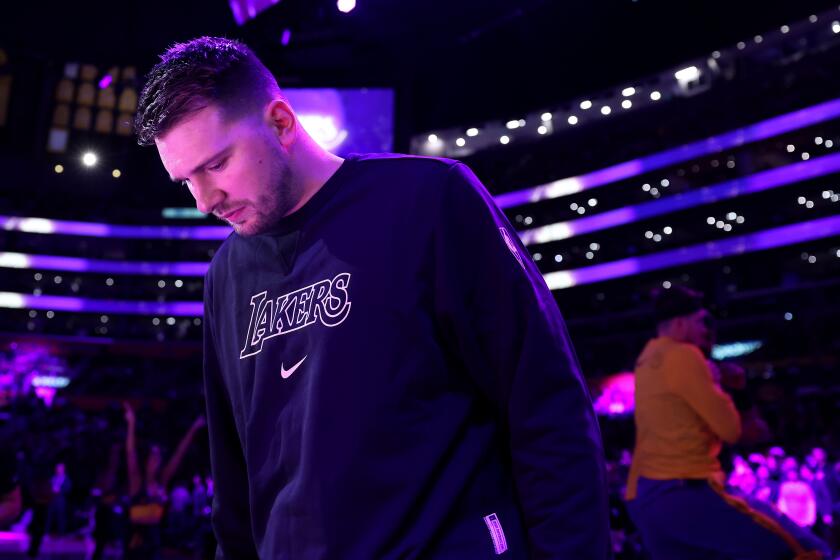OTL Hands Often Hurting Hands
- Share via
SAN DIEGO — Over-the-line is noted for its association with beer, bikinis and the blasphemous names of its teams. That’s not necessarily bad, but it doesn’t have much to do with the game itself.
It is a simple sport but hard to master in its most basic pursuits. Just catching the ball can be difficult, if not an act of courage.
The men who play this game play with their bare hands.
While OTL permits women to use fielder’s gloves, the sport prohibits the men from using any form of padding--even mittens--to cushion the blow when ball meets hand.
When it comes to playing defense in OTL, the hands don’t have a chance if the heart is not in it.
Bruised palms, jammed knuckles and broken fingers have often been as common home runs. Some of the best players have the ugliest hands. The years of head-on--or hands-on--confrontations with sizzling line drives take their toll.
“Some guys have definitely got some crooked fingers,” said Steve Miner, whose Beachcomber team will seek its third consecutive men’s open division championship of the Old Mission Beach Athletic Club World Championships at Fiesta Island this weekend. “But it’s just something you live with if you play over-the-line.
“I’m fortunate. I’ve never had a real serious injury. I’ve seen some pretty ugly things. I’ve seen some fingers that are obviously torn up pretty bad.”
But Miner suffered the most memorable hand injury in recent years, a bloody compound fracture of the little finger of his right hand the final day of Beachcomber’s charge to the open title in 1988.
Miner, 42, was playing his 21st competitive season of OTL without ever having won the OMBAC event. When he went down in winners’ bracket final that Sunday afternoon, he had no intention of quitting.
“When the paramedics came over, I was kind of indignant to them,” Miner said. “I said, ‘Tape it up or do what you have to do about it. I’m not going to the hospital, because I’m going to play ball.’ ”
In OTL, the three-man teams play a stacked defense inside the open-ended rectangular area that begins at “the line,” 55 feet from the batter. On defense, Miner plays the “up man” position, stationing himself 10 feet behind the line. John Torchia, who plays the middle-man position for Beachcomber, can still picture Miner lunging to his left to make that unfortunate attempt two years ago.
“A lot of times, you have to dive, and sometimes you have to one-hand the ball,” said Torchia, 40, a three-time OMBAC open champion. “You tend to cup your hand, and that’s when you can blow out a finger real easily.”
Miner, Torchia and 37-year-old Billy Bright, each considered among the best 15 players in San Diego, will return for top-seeded Beachcomber.
It is said that only the best hitting teams get to the last day of competition, but that is when the best hands take over.
“You’ve got to be able to hit the ball, but in the OMBAC World, a good defensive team has always won,” said Gary Romano of fourth-seeded Ryno Athletic Club.
In a recent issue of Over-The-Line Magazine, Bright, Miner and Romano were rated the top three players of the 1980s in San Diego. All know what it’s like to play, and win, with their hands in pain.
“Some of the best defensive players that I know--much better defensive players than I will ever be--their hands are banged up pretty badly,” Romano said. “Crooked fingers and things. It seems like when guys get a finger like that, over the years they keep injuring it. They have it taped up all the time.”
Exactly why the baseball mitt was left out of OTL remains as big a mystery as the exact ancestry of the game. No one seems to know if OTL was invented or a ball and bat just washed up on the beach one day and people started playing.
“It’s like the origins of stickball,” said Mike Curren, 60, who founded the OMBAC tournament in 1954 and is considered San Diego’s leading historian on the sport. “It’s a game that just evolved. We never used gloves. That would make it too easy.
“Back then, most kids didn’t have a glove.”
Curren, who first played OTL as a boy in the 1940s, suggests the pursuit of 60-m.p.h. line drives from 60 feet away is less hazardous than it once was. The sport now has its own ball, with a rubber coating. The old softballs had a rock-solid shell.
“We used the softball, but they stayed like a croquet ball,” he said. “We broke our fingers all the time. I remember when we had 10 to 12 broken fingers in a day. That wasn’t any fun. It usually happened because you were a little hesitant, because you were afraid of the ball.”
That doesn’t mean injuries have been eliminated.
“If you play for a period of time, you’re going to get some dislocated fingers,” Miner said. “You can’t avoid it. Sometimes I play better when I’m hurt.”
That was never more evident in 1988, when Miner, his pinky in two pieces, and Beachcomber came out of the losers’ bracket to upend The Pennant Pups in the final.
In 1989, Miner, Torchia and Bright stayed injury free. Fifteen minutes after they captured their second straight OMBAC title, they were measured for championship rings. Weeks later, when the gold engraved rings were delivered, none of them fit. The rings were two, maybe three sizes too large.
The hands had been swollen during the fitting.
More to Read
Go beyond the scoreboard
Get the latest on L.A.'s teams in the daily Sports Report newsletter.
You may occasionally receive promotional content from the Los Angeles Times.









